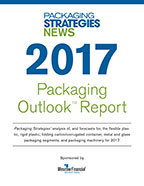Cover Story: Robotics
The robotic movement
Robots lend an arm to packaging solutions



KEBA's Intelligent Motion multi-robot control KeMotion increases productivity and decreases power consumption.



It is no secret that robots and automation are in big demand in the packaging industry, from pick and place applications to robotic palletizing and everywhere in between. The use of vision is on the rise with these systems too. More packagers are placing value on increased efficiency, speed and cost savings. And while you may pay more up front for these systems, the return on investment usually results in a big positive. According to Rick Tallian, consumer industry manager, ABB Robotics (abb.com), packagers can see a payback on these systems within a couple of years.
“The cost is important, as most new robotic installations are analyzed from labor savings perspective.”
Tallian went on to say that the advantage of robots in the food and beverage industry is that robot performance is improving. “Our robots are performing more picks per minute, handling multiple products per pick cycle or handling larger products,” he says.
Performance, efficiency and flexibility are just some of the features that make robots such a viable option, but quality dictates just how efficient the new system is.
“The key to a successful system implementation is to choose a top-quality robotic solution. Other factors to consider include packaging machinery provider experience and expertise as well as design and engineering. If companies ensure they have the right solution and not the best priced solution, the payoff will be great, resulting in performance increases and high reliability,” says Chris Follows, President, Propack (propack.on.ca).
“Solutions designed specifically for any given food packaging application will maximize uptime, productivity and total cost of ownership,” continues Follows.
Efficiency is king
Depending on the system need, robots can usually be added to the line to increase the speed and accuracy. Such is the case with ABB Robotics’ recent launch of a new 8kg model IRB 360 FlexPicker. The stronger model can handle up to 100 cycles per minute and offers another hot customer request: a smaller footprint, while still offering big results. The 8kg version of the IRB 360 robot has been re-engineered to handle higher payloads and improved pick-and-place performance.
The upgrade expands the IRB 360 FlexPicker’s other existing advantages, such as a hygienic design for washdown applications and superior conveyor tracking performance, including tracking high speed indexing conveyor belts. In addition to handling flow wrapped products, the IRB 360 FlexPicker is ideal for the direct picking and placing of unwrapped food products into primary wrappers and loading meat products into trays. The launch of the improved robot is in line with consumer demand and industry trends.
“We see a continued increase in sales in the food and beverage business. ABB as well as others are investing in new technologies to continue to increase robotic performance. We are also seeing significant advancements in vision systems which are increasing the prevalence of vision systems being used in a wide range of food and beverage applications,” adds Tallian.
Also designed to move more product at high speed motion, BluePrint Automation’s (bpa-flexolutions.com) stacking and loading solution is a custom end-effector used on a delta style robot to form stacks of product. It then loads these stacks into various horizontal form, fill and seal machines; including continuously moving flow wrapper chain in-feeds or indexing thermoform machines.
By utilizing a DELTA style robot with the stacking end-effector, BluePrint Automation can load entire stacks of product into a continuously moving tray conveyor. The vision system accepts product from integrated bulk feeding process, or other methods of product delivery.
The stacking and loading solution increases traditional robot productivity by up to 50%, is highly efficient and integrates to existing process.
|
Why do customers opt for robotic packaging equipment?
Answers compiled from input from ABB, Adept, KEBA and Staubli |
Taking control
Robotic companies are always looking for ways to upgrade existing technology for increased throughput. Staubli (staubli.com) has launched a comprehensive load balancing software package, called LINEmanager, to guarantee product flow integrity within robotic packaging lines. With this software, it is possible to control the conveyor and robot speeds. The software handles all communication between the in-feed vision system, the robots and both the in-feed and out-feed conveyor to optimize part pick and place speeds. It functions by identifying the incoming parts as detected by the vision system and then assigns a robot to pick it, a trajectory and a place location. Thus the software has complete part traceability throughout the system.
The software addresses the challenges of managing a random product in-feed, orienting and sorting product, managing a line with multiple robots, traceability issues and ensuring all cavities are filled for downstream processing. With this system, robots are not run at full speed but are speed controlled along with the in-feed conveyor to guarantee that either all the incoming parts are used or that all out going cavities are filled. Multiple robots and/or multiple parts are handled effortlessly allowing the same guarantees with complete part traceability. Parallel, counter and mono flow configurations are possible.
LINEmanager was shown for the first time in the U.S. at PACK EXPO Las Vegas just last month.
For optimal control and continuous motion, KEBA (keba.com) has created its “intelligent Motion” multi-robot control KeMotion to increase productivity and decrease power consumption. The Intelligent Motion allows the control over multiple robots in a shared working space without getting in the way of each other. The look-ahead movement planning ensures that the robot arms’ motion is planned with consideration to all moving objects, that way stoppages are avoided.
The continual motion of the robots is without abrupt start and stops, which leads to increased throughput and the decreased power consumption.
To the future, and beyond
The use of robotics is growing for various industries. According to the Robotic Industries Association (RIA; robotics.org), North American robotics companies have set new sales records through June 2013. A total of 10,854 robots were ordered from North American robotics companies in the first six months of 2013, an increase of 1.9% in units over the same period in 2012 and 1.3% above the previous first-half record set in 2005. The RIA notes that activity was especially strong in non-automotive industries including food and consumer goods.
And while it is clear that the robotic trend is not just a trend, but a lasting movement, I tapped into some experts to get their insight into what the future holds. Experts agree that robots are here to stay and will continue to increase for use in the food and beverage packaging markets.
“Robotic applications continue to grow for the food sector. When robotics solutions are well-executed the quality and performance are second to none. Automation in food packaging provides production efficiencies, increased uptime and low operating costs. We see automation continuing to grow in beverage packaging as well, particularly in the area of multi-flavor rigid packaging configurations and liquid pouches in single or multi flavor,” Follows says.
So, what’s driving some of this burgeoning demand?
“The Food Safety Modernization Act, and changing consumer tastes. We believe that there is a huge potential in this market that will be accessed by showing packaging companies what this technology can do for them. Adept’s USDA compliant product has been described by customers as a ‘game-changer’ in this industry,” says Glenn Hewson, SVP Global Marketing, Adept Technology (www.adept.com).
The benefits of using robots in food packaging are clear; they offer safety and sanitation, gentle handling, high speeds, flexibility and consistency. And in some cases, they do that while taking up less floor space. As more and more robots are being integrated in packaging lines across the U.S, it is clear that they are not a passing trend. Robots promise less downtime and higher outputs, lending packagers a valuable helping arm.
Looking for a reprint of this article?
From high-res PDFs to custom plaques, order your copy today!












